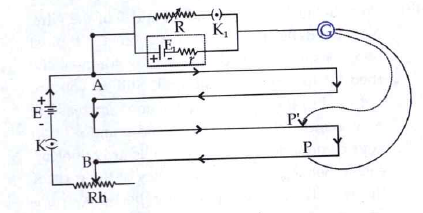Explain the determination of the internal resistance of the cell using voltmeter. Solution in Tamil
(i) The measure the internal resistance of a cell, the circuit connections are made as shown in Figure. The end C of the potentiometer wire is connected to the positive terminal of the battery B and the positive terminal of the battery is connected to the end D through a key K1. This forms the primary circuit.
(ii) The positive terminal of the cell ξ whose internal resistance is to be determined is also connected to the end C of the wire. The negative terminal of the cell ξ connected to a jockey through a galvanometer and a high resistance.

(iii) A resistance box R and key K2 are connected across the cell ξ. With K2 open, the balancing point J is obtained and the balancing length CJ=l1 is measured. since the cell is in open circuite, its emf is
ξ=l1 ..(1)
(iv) A suitable resistance (say, 10Ω) is included in the resistance box and key K2 is closed. Let r be the internal resistance of the cell. The current passing through the cell and the resistance R is given by
I=ξR+r
The potential difference across R is
V=ξRr=r
(v) When this potential difference is balanced on the potentiometer wire, let l2 be the balancing length.
Then ξRR+r .....(2)
From equations (1) and (2)
R+rR=l1l2
1+rR=l1l2
r=R[l1−l2l2]
∴r=R[l1−l2l2]
(iv) Subsituting the values of the R,l1andl2 the internal resistance of the cell is determined. The experiment can be repeated for different values of R. It is found that the internal resistance of the cell is not constant but increases with increases of external resistance connected across its terminals.
Similar Questions
Explain the determination of the internal resistance of a cell using voltmeter.
02:50View SolutionExplain the determination of the internal resistance of a cell using voltmeter.
02:50View SolutionExplain the determination of the internal resistance of a cell using voltmeter.
02:50View SolutionThe reading on a high resistance voltmeter, when a cell is connected across it, is 2.2 V. When a 5 Ω resistance is connected across the terminals of the cell in parallel with the voltmeter, the reading is 1.8 V. Determine the internal resistance of the cell.
View SolutionDefine internal resistances of a cell. explain how the internal resistance of a aprimary celle can be determined using a Potentiometer.
03:31View SolutionA voltmeter resistance 500Omega is used to measure the emf of a cell of internal resistance 4Omega . The percentage error in the reading of the voltmeter will be
View SolutionExplain the use of potentiometer for determining he internal resistance of cell.
 07:42View Solution
07:42View SolutionPotentiometer is used to determine the internal resistance of a cell using potentlometer:- A potentiometer is a device for ________.
04:01View Solution

